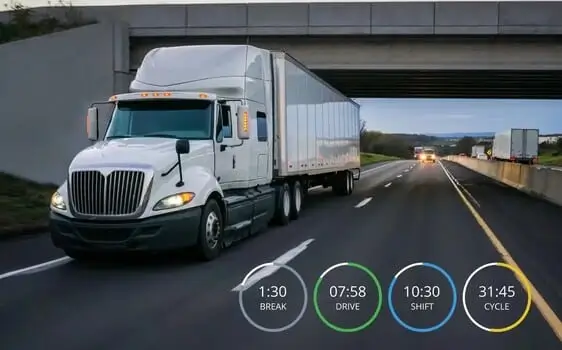

October 28, 2022

2615 Views

7 min read
Understanding DOT Hours Of Service Rules
Page Contents

As a truck driver, you are required to follow certain hours of service (HOS) rules set by the Department of Transportation (DOT). These rules are designed to ensure that you get the proper amount of rest and avoid fatigue while driving.
The DOT hours of service rules can be confusing, but it’s important to understand them in order to stay compliant and avoid potential penalties. In this article, we’ll provide an overview of the DOT hours of service rules and explain how they apply to truck drivers.
What Are The Dot Hours Of Service Rules?
The DOT hours of service rules are regulations that govern how long truck drivers can stay on the road. These rules are designed to promote safety by preventing driver fatigue.
The DOT hours of service rules vary depending on the type of truck you are driving and the type of cargo you are carrying. However, in general, the DOT hours of service rules state that truck drivers must take a break after driving for 8 hours. Drivers must also take a 30-minute break after every 8 hours of driving.
The 14-Hour Rule
One of the most important DOT hours of service rules is the 14-hour rule. This rule states that property-carrying truck drivers can only drive for a total of 14 hours in a day. This includes all driving time, as well as any time spent waiting for a load or dealing with traffic delays.
After 14 hours, truck drivers must take at least 10 consecutive hours off before driving again. This 10-hour period can be used for sleeping, eating, or any other activities.
The 11-Hour Rule
The DOT hours of service rules also apply to drivers of passenger vehicles. The 11-hour rule states that these drivers can only drive for a total of 11 hours in a day.
After 11 hours, drivers must take at least 8 consecutive hours off before driving again. As with property-carrying drivers, this 8-hour period can be used for sleeping, eating, or any other activities.
The 60/70-Hour Rule
In addition to the 14-hour and 11-hour rules, there is also a 60/70-hour rule. This rule applies to all truck drivers and states that drivers can only drive for a total of 60 hours in a 7-day period or 70 hours in an 8-day period.
After reaching the 60 or 70-hour limit, truck drivers must take at least 34 consecutive hours off before driving again. This 34-hour period must include two periods of uninterrupted sleep.

FOR COMPREHENSIVE FLEET
MANAGEMENT SOLUTIONS
The 30-minute Break Rule
Truck drivers must also take a 30-minute break after driving for 8 hours. This break can be used for any purpose but must be taken within the first 8 hours of driving time.
After taking the break, drivers can continue driving for up to 6 more hours. This means that drivers can be on the road for a total of 14 hours in a day, as long as they take the proper breaks.
Exceptions To The DOT Hours Of Service Rules
There are some exceptions to the DOT hours of service rules. These exceptions include:
The 30-Minute Break Exception
As we mentioned, drivers must take a 30-minute break after driving for 8 hours. However, there is an exception to this rule for short-haul drivers.
-
- Short-haul drivers are defined as drivers who:
-
- Drive within a 100-air-mile radius
-
- Have at least 10 consecutive hours off between each day of driving
-
- Do not exceed a total of 15 hours of on-duty time in a day
If you meet all of the above criteria, you are not required to take the 30-minute break. However, you must still take the 8-hour break after 14 hours of driving.
The 16-Hour Short-Haul Exception
The 16-hour short-haul exception is similar to the 30-minute break exception. This exception allows drivers to extend their driving time by up to 2 hours if they meet certain criteria.
To qualify for the 16-hour short-haul exception, drivers must:
-
- Start their day with at least 10 consecutive hours off duty
-
- Drive no more than 16 hours total during the day
-
- Have at least 8 hours off duty between driving shifts
-
- End their day with at least 10 consecutive hours off duty
This exception is designed for drivers who make local deliveries and return to their home terminal each day. If you live more than 150 miles from your terminal, you’re not eligible for the 16-hour short-haul exception.
Adverse Driving Conditions
The DOT hours of service rules include an exception for adverse driving conditions. This exception allows drivers to extend their driving time by up to 2 hours if they encounter hazardous weather or road conditions.
To qualify for the adverse driving conditions exception, drivers must:
-
- Be unable to complete their trip within the allowed time due to bad weather or road conditions
-
- Not be driving in violation of any other DOT hours of service rule
-
- Keep a record of the adverse driving conditions, including the time, date, and location
Why Are The Dot Hours Of Service Rules Important?
The DOT hours of service rules are important because they help to promote safety on the roads. Driver fatigue is a major cause of accidents, so the DOT hours of service rules help to prevent these accidents by requiring drivers to take breaks and get the proper amount of rest.

How To Stay Compliant With The Dot Hours Of Service Rules
The best way to stay compliant with the DOT hours of service rules is to keep a log of your driving time. This log should include all hours spent driving, as well as any time spent waiting for a load or dealing with traffic delays.
You can use a paper logbook or an electronic logging device (ELD) to track your hours. If you use an ELD, it must be certified by the DOT. You should also make sure to take your breaks when required. You can use a timer to remind you when it is time to take a break.
If you are ever in doubt about the DOT hours of service rules, you can always check the DOT website or give them a call. They will be happy to answer any questions you have.
Proposed Changes To The Hours Of Service Rules
The DOT is always looking for ways to improve safety on the roads. As such, they are constantly evaluating the hours of service rules and proposing changes to these rules.
Some of the proposed changes to the hours of service rules include:
-
- Reducing the maximum driving time from 11 hours to 10 hours
-
- Reducing the maximum on-duty time from 14 hours to 13 hours
-
- Requiring drivers to take a 30-minute break after driving for 8 hours
-
- Adding a new limit of 60 hours of driving in a 7-day period
These proposed changes are still under review and have not been finalized. The hours of service rules are subject to change at any time, so it is important to stay up-to-date on these changes.
What Are The Penalties For Violating The Dot Hours Of Service Rules?
The penalties for violating the DOT hours of service rules can vary depending on the severity of the violation. Some of the possible penalties include fines and suspension of your commercial driver’s license (CDL)
At FleetCare, we want you to stay compliant with the DOT hours of service rules. We offer a variety of compliance tools, including an electronic logging device (ELD) that can help you track your hours and take your breaks.
With proper compliance, you can avoid penalties and help to keep the roads safe.
Sign up for Exclusive Trucking Tips
Test







